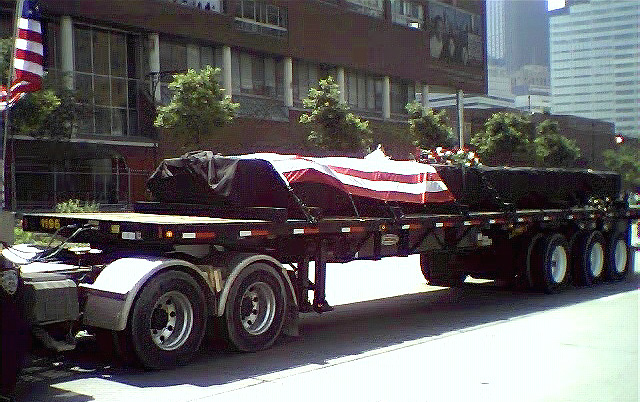Circumnavigating the frozen zone
Job done? Another mournful parade
photos: adpFisher
copyright © 2002-2005 Diane Fisher.
SOUTH OF 14TH STREET, NEW YORK CITY, Thursday,
30 May 2002--By the time I got my hands on a
camera, the last flatbed bearing the WTC's last
steaming twisted girder had long since made its
way down Greenwich Street, so my craving--and
that's what it was--to shoot each will forever
be just conceptual art. The only one I got to
capture digitally was the shrouded column, the
last extracted, a centerpiece in the slightly
surreal cortege that concluded the private
ceremony at ground zero today--("traditional")
Memorial Day--punctuating the end of the
enormous recovery effort. Henceforth the
16-acre excavation is officially a construction
site, but those who've worked there every day
or most since 11 September surely won't be
able to absorb that redefinition overnight.
<update, 9 June:
Body parts of perhaps a dozen more victims
have been found in the past few days in nearby
buildings.>
<update, 25 June: The recovery operation's
real
final day>
After a brief ceremony--no speeches--that was
scheduled to begin at 10.29 a.m.,
the time the second tower collapsed, two cops
on foot, then two cop cars, led a parade up
West Street, followed by a FDNY ambulance
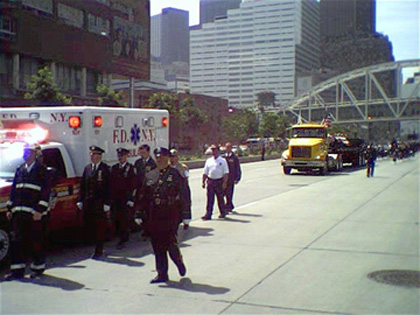 carrying an empty stretcher symbolizing
all unrecovered (most) victims, then the
yellow-cab flatbed bearing the column,
and a pipe and drum unit--one of two that
carrying an empty stretcher symbolizing
all unrecovered (most) victims, then the
yellow-cab flatbed bearing the column,
and a pipe and drum unit--one of two that
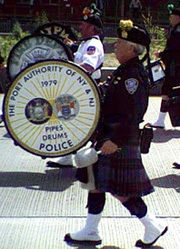 marched--along with firefighters, cops, workers
from the site (viewers applauded them all, as
they had on this same street back in the fall),
and members of victims' families, who wore
or held up photos. "God bless you,"
those watching said to them. Family members
said, "God bless you" back. I hear
the families in tv interviews describing
the vast excavation as a final resting place.
I don't think so. Except for remains that have
been found, and will be at Fresh Kills, I'd put
the final resting place somewhere east, wherever
the wind blew that gray dust. Call it burial
at sea. Or, perhaps more realistically, read
Mimi Gauthier LeBien's
take at the time: "Thousands of
little holy flying hosts. ... "
marched--along with firefighters, cops, workers
from the site (viewers applauded them all, as
they had on this same street back in the fall),
and members of victims' families, who wore
or held up photos. "God bless you,"
those watching said to them. Family members
said, "God bless you" back. I hear
the families in tv interviews describing
the vast excavation as a final resting place.
I don't think so. Except for remains that have
been found, and will be at Fresh Kills, I'd put
the final resting place somewhere east, wherever
the wind blew that gray dust. Call it burial
at sea. Or, perhaps more realistically, read
Mimi Gauthier LeBien's
take at the time: "Thousands of
little holy flying hosts. ... "
You'd have been hard put to know from the parade
that about 2000 civilians died. As ever, the event
seemed to be about the emotional needs of the
uniformed services, with a bow this time to the
construction workers. I won't dwell on the awesome
job they did--finished months ahead of schedule,
no fatal accidents, millions under budget. That
speaks eloquently for itself, and I hope when
this story is retold no one ever forgets what
those workers have done for this city without
a break for eight and a half-plus months.
If you watched alertly, you saw midparade,
unheralded, the governor and most recent ex-mayor
shuffling along on either side of the current
mayor (my 16th shot; this silly camera--no
memory card--maxes out at 15; that's the truth).
A follow-up transitional ceremony, for family
members disgruntled by the planning for today's
(don't ask), is scheduled for Sunday morning
on Liberty Street, still in the frozen zone.
The mayor--who shows no inclination to pander
or sentimentalize--politely declined his invitation.
I waited at the city end of the Chambers Street
pedestrian bridge, as close as civilians could get,
till shortly before the procession started a nice
cop nearby was kind enough to announce that it
was going to travel up the southbound lane. West
Street is a highway, widened by a median.
So I crossed to the river side and walked up to
just below Harrison Street and Pier 25, where I
first repaired the morning of 11 September when
the debris cloud kept me from getting closer to
the fallen towers. The basin between
![[photo]](gx/_wtc2p25.jpg)
that pier and Hudson River Park (top and bottom
respectively in photo, looking north), which has
held mostly sailboat moorings for several years
and last winter the barges where a crane loaded
the broken girders, now is empty. The crane (the
white diagonal slash in front of Borough
|
![[photo]](gx/_wtc_515.jpg) of Manhattan Community College in photo, shot in mid-May)
of course is gone too. Left behind were canvas
bags containing E.P.A. gear to collect
of Manhattan Community College in photo, shot in mid-May)
of course is gone too. Left behind were canvas
bags containing E.P.A. gear to collect
|
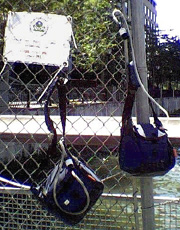 air samples--a familiar sight near ground zero.
The mooring area was relocated to less protected waters.
air samples--a familiar sight near ground zero.
The mooring area was relocated to less protected waters.
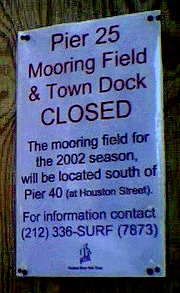
|
The sidewalks around the site were busier today
than they've been lately, and the mood was a strange
but understandable mix of grief and festivity.
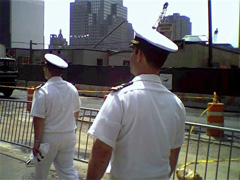 Last week was Fleet Week, but by today the
fleet apparently had fled. Sailors still were
in sight around town, no less at ground zero,
Tuesday. While the crowd at the WFC North Cove
watched the spectacle of the inaugural nautical
pageant last week, crews lined up on the decks,
most presumably seeing the hole in the sky behind
the WFC for the first time. (Here, though you'd
hardly know it from the photo, the crew line up
stem to stern on the deck of the carrier Iwo Jima,
about to pass
Last week was Fleet Week, but by today the
fleet apparently had fled. Sailors still were
in sight around town, no less at ground zero,
Tuesday. While the crowd at the WFC North Cove
watched the spectacle of the inaugural nautical
pageant last week, crews lined up on the decks,
most presumably seeing the hole in the sky behind
the WFC for the first time. (Here, though you'd
hardly know it from the photo, the crew line up
stem to stern on the deck of the carrier Iwo Jima,
about to pass
![[photo]](gx/_wtc2fwk.jpg) the Coast Guard training vessel Eagle opposite
the WFC.) What does Fleet Week signify, a young
Israeli at the WFC asked me--a show of military
muscle? Why is that fireboat hanging just outside
the North Cove, spraying all its hoses? Should
I tell him New Yorkers just like to have fun?
Fleet Week usually is exuberantly international.
I saw no sign this year that any other nation's
navy was in town, and especially missed those
charming French uniforms on the streets
(I admit to having not read any news accounts
of the event).
the Coast Guard training vessel Eagle opposite
the WFC.) What does Fleet Week signify, a young
Israeli at the WFC asked me--a show of military
muscle? Why is that fireboat hanging just outside
the North Cove, spraying all its hoses? Should
I tell him New Yorkers just like to have fun?
Fleet Week usually is exuberantly international.
I saw no sign this year that any other nation's
navy was in town, and especially missed those
charming French uniforms on the streets
(I admit to having not read any news accounts
of the event).
For the first time since the day I found it, the
doors of the
Ground Zero Relief organization's warehouse
on Spring Street were closed today.
The job isn't entirely done; the project
supports Fresh Kills as much as ground zero, and
Fresh Kills has a few more weeks' work ahead.
I mused that Fresh Kills too surely was shut
down for the day and the volunteer project's
principals certainly must be at the ceremony
too. The project began at Pier 40 when sculptor
Rhonda Roland Shearer recognized that official
agencies weren't meeting all rescuer needs and
stepped in to help. Once the bureaucracies got
their acts together, many needs, from odd-size
workboots to lip balm, still went unanswered.
Miners' helmets with lights were in short supply.
Needs persisted because contamination required
that clothing and other things be discarded
after one-time use. Shearer never missed a beat.
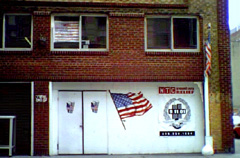 Her daughter provided warehouse space and
administrative skills of her own, other volunteers
pitched in, and Shearer's organization continued
its effective effort to plug the gaps--with, at
best, grudging acceptance from the bureaucracies.
The Times and a local public radio station covered
the story more than once and I observed first-hand
the gratitude of rescue and recovery workers
placing orders for supplies at the warehouse.
After the death of Shearer's husband, Stephen Jay
Gould--front page news a couple of weeks ago--I
noticed business going on as usual on Spring Street.
When I got home tonight and turned on the radio,
"All Things Considered" was just starting
an interview with Shearer for a feature about Art
Science Research Lab, an interesting collaboration
between her and Gould that links the disciplines,
with a focus on Marcel Duchamp. On this of all days,
not a word about WTC relief support. I believe
that's what's called compartmentalization.
Her daughter provided warehouse space and
administrative skills of her own, other volunteers
pitched in, and Shearer's organization continued
its effective effort to plug the gaps--with, at
best, grudging acceptance from the bureaucracies.
The Times and a local public radio station covered
the story more than once and I observed first-hand
the gratitude of rescue and recovery workers
placing orders for supplies at the warehouse.
After the death of Shearer's husband, Stephen Jay
Gould--front page news a couple of weeks ago--I
noticed business going on as usual on Spring Street.
When I got home tonight and turned on the radio,
"All Things Considered" was just starting
an interview with Shearer for a feature about Art
Science Research Lab, an interesting collaboration
between her and Gould that links the disciplines,
with a focus on Marcel Duchamp. On this of all days,
not a word about WTC relief support. I believe
that's what's called compartmentalization.
The hed on the Times lede story this morning read:
"F.B.I. Chief Admits 9/11 Might Have Been
Detectable." (I hate that euphemistic
"9/11" shorthand. NYC and D.C. weren't
9/11'd. We were attacked. Say it.) This isn't
the occasion to say much more than it's about
time this administration expressed at least
embarrassment over some of its possibly?
probably? fatal blunders, on one hand and, on
the other, how very predictable that, instead
of repopulating security agencies with fresh
thinkers, the Bushies are using their blunders
as an excuse to further restrict civil liberties.
They'd love to blame all the F.B.I.'s failings
on Clinton appointee Louis Freeh without
acknowledging that Clinton was known to want
to fire Freeh but dared not because of Freeh's
investigations on behalf of the sanctimonious
impeachment hypocrites in Congress, and the
firestorm the hypocrites' sex police media
partners would have visited on him.
<update (commentary): "Where is
Louis
Freeh? Why isn't former FBI director
Louis Freeh being hauled before Congress
over the September 11 intelligence failure?"
Eleanor Clift asks (and answers) in a 21 June
2002 Newsweek "Web Exclusive.">
Hmmm, well, I must note too that while anecdotal
evidence of people walking around terrified
astonishes me, a loud blast nearby shattered
the quiet one morning last weekend and
I confess to being truly shaken momentarily.
That shocked me as much as the still unexplained
explosion (an isolated thunderclap or huge
firecracker set or some such). Although nothing
in this immediate neighborhood could qualify
as a target, my pre-reasoned response was
that they'd done it again, so close this time
I wouldn't get away with being a spectator.
Reason returned in seconds, but in those seconds
I was scared.Bush operatives had been
all over the news for days issuing baseless
warnings of incipient attack. Although anyone
with an IQ above double digits had to recognize
the irresponsible alarms as an outrageously cynical
tactic to divert attention from breaking news
of the administration's gaping security lapses
![[photo]](gx/_wtc2shl.jpg) before the all-too-real attack (on 10 September,
e.g., Ashcroft rejected an F.B.I. request for more funds
to track domestic Al Qaeda activities), relentless
fear-mongering does have its effects. Given that in any
event individual preparedness is impossible, watch for
a campaign before long encouraging some 21st century
version of basement fallout shelters--as soon as these
CEOcrats work out a way for their pals to get richer
from the scheme.
before the all-too-real attack (on 10 September,
e.g., Ashcroft rejected an F.B.I. request for more funds
to track domestic Al Qaeda activities), relentless
fear-mongering does have its effects. Given that in any
event individual preparedness is impossible, watch for
a campaign before long encouraging some 21st century
version of basement fallout shelters--as soon as these
CEOcrats work out a way for their pals to get richer
from the scheme.
West
Broadway, 9 July 2002
--adpF, 30 May 2002
|
|
